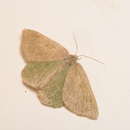Conservation Status
provided by University of Alberta Museums
No concerns.
- license
- cc-by-nc
- copyright
- University of Alberta Museums
Cyclicity
provided by University of Alberta Museums
In Alberta adults fly in May and June, peaking mid May through early June.
- license
- cc-by-nc
- copyright
- University of Alberta Museums
Distribution
provided by University of Alberta Museums
A northern species, found from Alaska and NWT south to New England, south in the mountains to CA, NV and CO (Ferguson 1985). In Alberta it occurs throughout the boreal and foothills regions, and locally in the aspen parkland south to the Rumsey area.
- license
- cc-by-nc
- copyright
- University of Alberta Museums
General Description
provided by University of Alberta Museums
"A small dusky green geometrid with a faint (sometimes absent) transverse PM line. Flight-worn individuals can fade to a dusky tan, quite unlike the dusky olive of freshly emerged moths. The small size, uniform green abdomen and absence of a PM line will separate this species from other emeralds (Nemoria, Synchlora and Cheteoscelis).
Ferguson (1985) recognized two subspecies, both of which occur in Alberta. The nominate subspecies is slightly smaller with more distinct transverse lines, and occurs across the boreal region to the foothills. Subspecies viridipennata (Hulst) occurs from the Rocky Mountains west.
"
- license
- cc-by-nc
- copyright
- University of Alberta Museums
Habitat
provided by University of Alberta Museums
Dry open mixedwood and pine forest, peat bogs and grasslands.
- license
- cc-by-nc
- copyright
- University of Alberta Museums
Life Cycle
provided by University of Alberta Museums
"The caterpillar is green with a brown dorsal stripe. The body is slender and without noticeable bumps or protrusions, and the head and first thoracic segment each bear a pair of pointed horns (Wagner et al. 2001). The pupa overwinters. The adults are strictly diurnal.
In the boreal forest, adults fly in open peat bogs, but this species is also found in dry montane and eroding river valley habitats associated with patches of bearberry (Arctostaphylos uva-ursi).
"
- license
- cc-by-nc
- copyright
- University of Alberta Museums
Trophic Strategy
provided by University of Alberta Museums
Known larval hosts include a variety of shrubs in the Betulaceae, Salicaceae, Ericaceae and Rosaceae (Wagner et al. 2001). Associated with Labrador Tea (Ledum groenlandicum) and bearberry (Arctostaphylos uva-ursi) in Alberta.
- license
- cc-by-nc
- copyright
- University of Alberta Museums
Mesothea incertata
provided by wikipedia EN
Mesothea is a monotypic moth genus in the family Geometridae described by Warren in 1901. Its only species, Mesothea incertata, the day emerald or plain emerald, was first described by Walker in 1863.[1][2][3][4][5] It is found in North America.[2]
The MONA or Hodges number for Mesothea incertata is 7085.[6]
Subspecies
It has two subspecies:
-
Mesothea incertata incertata (Walker, 1863) i g
-
Mesothea incertata viridipennata (Hulst, 1896) i c g
Data sources: i = ITIS,[2] c = Catalogue of Life,[3] g = GBIF,[4] b = Bugguide.net[5]
References
- license
- cc-by-sa-3.0
- copyright
- Wikipedia authors and editors
Mesothea incertata: Brief Summary
provided by wikipedia EN
Mesothea is a monotypic moth genus in the family Geometridae described by Warren in 1901. Its only species, Mesothea incertata, the day emerald or plain emerald, was first described by Walker in 1863. It is found in North America.
The MONA or Hodges number for Mesothea incertata is 7085.
- license
- cc-by-sa-3.0
- copyright
- Wikipedia authors and editors

